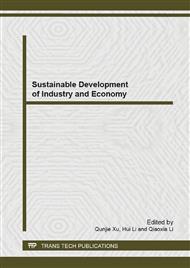p.509
p.513
p.517
p.522
p.526
p.533
p.537
p.541
p.545
Research on the Present Situation of China's Power Sources Based on Multi-Objective Comprehensive Evaluation Method
Abstract:
Multi-objective comprehensive evaluation method is a new evaluation method which analysis on the sustainable development. This article is evaluating the present situation of the sustainable development of China's power source structure through this method, view to the future development. We select 7 indicators in order to reflect the economic effects, environmental effects and power production levels, and describe the sustainability degree, the development degree and the coordination degree from 2000 to 2007 in China. The research indicated that although the China's power source structure is being far away from the unsustainable critical point slowly, slowly approaches to the target point, but the way deviated from the path of the development of optimal path.
Info:
Periodical:
Pages:
526-532
Citation:
Online since:
December 2013
Authors:
Price:
Сopyright:
© 2014 Trans Tech Publications Ltd. All Rights Reserved
Share:
Citation:


